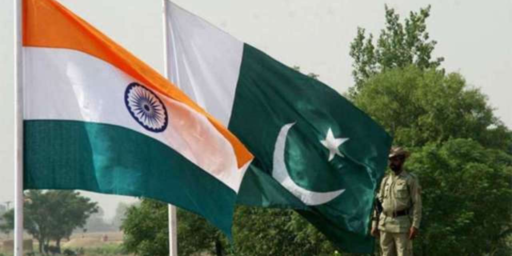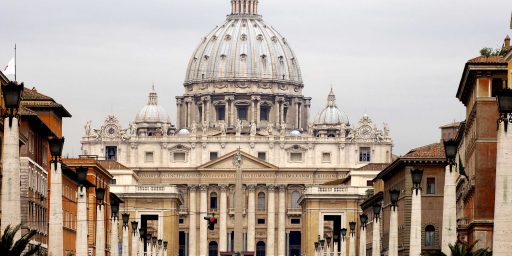Diplomats and War
Back in May, James Joyner and I wrote a piece for TCS Daily, Armed Diplomats? When State and Stability Operations Collide about the conflicting roles and missions of State Department diplomats and those of the US Military. The article noted that diplomats (as well as the various support staff needed to run a diplomatic missions, though they weren’t specifically mentioned in the article) are not trained to operate under combat conditions and are generally not armed nor armored. As a rule, most diplomats and staff in State are also older than the bulk of the US military, with the average age of diplomats being around 40. (State has mandatory retirement at age 65; age 55 for those involved in law enforcement-type activities.)
The Washington Enquirer ran a piece earlier this week that is germane to the discussion in the TCS Daily article: Security Fears Restrict US Diplomats.
This piece notes that US diplomats in 28 countries serve under lockdowns and prohibitions on travel and that dependents are not permitted to accompany Foreign Service Officers to 21 countries, according to an Associated Press survey of “State Dept. directives, warning, and officials.” Since the 1980s, when only two countries were deemed dangerous enough to trigger “danger pay,” the number has risen to 26 countries.
The piece focuses on the fact that this level of danger has consequences on the ability of the US Foreign Service to accomplish its mission. In the name of security, US embassies and other USG buildings have become more cut off from the local communities. In addition to making the US seem aloof, this means that it is more difficult for the citizens of a given country to access American officers and services. This is absolutely true.
Take, as an example, the American Library in New Delhi. The building, which dates from the late 1950s or early 1960s, is located on a major boulevard downtown. In addition to a large library and a theater, the building houses offices of several USG agencies and departments. In addition to local and American staff, the building also sees upwards of 5,000 Indian visitors per week. While in the building, the security of those Indians is a concern of the USG. [The US also operates libraries in Kolkata, Mumbai, and Chenai, each with their own issues.]
The building—where I had my office for part of my tour of duty in New Delhi as Information Officer—is certainly functional, if not beautiful in the non-public areas. For its time, it was certainly adequate to its role.
Today, it is not so. There has been a long-running argument between the embassy sections located in this building and the Security officers located in the Chancery, a few miles away and behind substantial walls, about what to do with this building, its functions, and its staff. Everyone would like to find a way to improve the building’s physical security, but that’s a tough nut to crack.
First, the building is, at most, only a hundred feet from the street. That does not comply with current security standards that want a 300-foot setback. The building was not constructed with bomb-proofing in mind and few doubt the consequences of a large car or truck bomb being detonated in front of the building. The walls of the building are not strong enough to hold contemporary ‘blast-proof’ windows and instead must rely on Mylar film and heavy curtains inside the windows with latticed brickwork on the outside. Whether this would defeat an RPG is a good question. It does, unquestionably, provide roosting places for pigeons and other Indian avians.
The biggest problem, though, is that the street it is located on is also a favorite for public demonstrations by Indians. These demonstrations need not be related to US foreign policy. In the seven or so months I spent in that building, there were at least eight demonstrations, each with thousands of participants, protesting something that the Indian government had done or was about to do. Unfortunately, Indian demonstrations can turn into riots with little apparent provocation.
To be sure, the US Embassy has implemented a lot of work-arounds. The building, though it has serious problems, is not a deathtrap. I won’t be discussing those work-around here, of course.
So, why doesn’t the USG just sell the building and build a more secure one, somewhere safer?
If you guessed ‘money’, you’re right. If you guessed ‘location’, you’re also right.
State’s budget does not have the money to construct a new building, meeting current safety and security standards. What money exists in the budget for construction—handled by the Overseas Building Operations, OBO—is going toward construction of new buildings in even less secure areas: Iraq and Afghanistan, for instance. [See this front page article from the July 5 issue of The Washington Post for the travails of OBO.]
Complicating the issue further is the fact of the geography of New Delhi. The city itself, like the District of Columbia, is small, occupying only 16 square miles. Nearly every square foot of the city, with the exception of government buildings and a few parks and monuments, is already occupied. A new US building, meeting security standards, cannot be built within the city limits without the Government of India’s permitting the USG to build on public park lands.
That leaves moving the building outside of the city, into a neighboring province. Imagine a Washington, DC-based embassy with its cultural mission sited in Fredericksburg, VA or Frederick, MD. Imagine how busy it would be. Given the traffic congestion in New Delhi, a visit to the library would easily turn into a full-day adventure.
As is the case everywhere, diplomatic missions rely on local government for the first line of defense against crime and terror. The Indian government does provide guards at all USG buildings—including some residences off the Embassy compounds—and they do their jobs in screening visitors before they get within the fences or walls. Just how effective they would be when confronting a drive-by truck bomb is also another matter.
So what’s to be done? One thing for sure is that there are no 100% guarantees for personal safety. But India is not considered a particularly dangerous country. It’s not one of those places that attracts danger pay and dependents are permitted at post. There is intrinsic danger in assignments to India, but FSOs and their families accept the risks—or they don’t bid on the assignments.
Other places, like Iraq, Afghanistan, Saudi Arabia, Bosnia, Congo, Sudan, Pakistan, are far more dangerous. Diplomats need a minimal level of security in order to be able to do their jobs. They need to be able to sleep without worrying that an incoming round will find their bedrooms. They need to be able to go from the office to meetings with different people both within and outside the local governments. Unaccompanied assignments generally assuage concern about the safety of their families, but introduce the strains of separation and the loss of control over what’s happening to their families located half a world away. Of course, these same anxieties affect members of the US military; the difference is that for the military it is understood that families are not part of the deployment equation.
Most current FSOs did not join the Foreign Service with the understanding that they would be separated from their immediate families. It was a possibility, but not likely over the past 30 years. They are going to have to change their expectations to take into account changed reality. Some will, as some already have, decide that they just aren’t cut out for the higher level of risk.
New State officers are realizing that they are working in a far more dangerous world now. People considering a career in diplomacy are going to have to factor danger into their decisions, as well as family separation and short tours of duty (which lead to a diminished sense of professional accomplishment). Either pay scales are going to have to improve dramatically or, I fear, standards are going to slip.






@John,
I’ve quoted you and linked to you here.